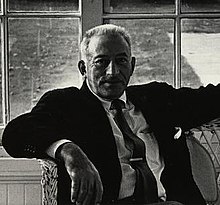Adolph Gottlieb
EARLY DAYS:
Adolph Gottlieb (March 14, 1903 - March 4, 1974) was an American abstract expressionist painter.
Adolph Gottlieb, was an American abstract expressionist painter born on March 14, 1903 in New York City. He grew up in an immigrant family and attended public schools in New York City. He was strongly influenced by his father, who was a rabbi and an amateur painter, and his mother, who was an ardent admirer of the arts. Gottlieb was also inspired by the diverse cultural influences of the Yiddish theater and the Borscht Belt comedy clubs.
Gottlieb began studying art at the age of 14 at the Art Students League of New York, where he was taught by artists such as Max Weber andGeorge Luks. He was also inspired by the work of American Cubists such as Stuart Davis and Charles Sheeler and the French Cubists such as Jean Metzinger and Robert Delaunay. In 1925, he had his first solo exhibition at the Opportunity Gallery in New York City.
Gottlieb's early works were characterized by their dark, somber palette and their focus on the human figure. His early paintings were mostly figurative, with an emphasis on mood and atmosphere. He also experimented with different media, including drawings, prints, and etchings.
In the late 1920s, Gottlieb became more interested in abstraction, and his work began to be influenced by Surrealism. He began to explore the possibilities of automatism and chance in his work, resulting in works that were more abstract and gestural. He also began to explore the relationship between color and form, and experimented with ways of combining abstract shapes and symbols to create representational images.
In the 1930s, Gottlieb's work began to move away from Surrealism and become more focused on abstraction. He began to explore the relationship between painting and sculpture and experimented with various materials and techniques, such as sand and plaster. He also experimented with different color palettes and geometric forms.
In 1941, Gottlieb had his first solo exhibition at the Museum of Modern Art in New York, which showcased his abstract expressionist works. In the 1940s and 1950s, his work became increasingly gestural and abstract, and he began to explore the relationship between color and form.
Gottlieb had a long and successful career as an artist, and his work has been exhibited in museums and galleries around the world. He is considered one of the most important American abstract expressionist painters, and his influence can be seen in the works of many other abstract expressionists.

Personal Details:
CAREER:
Adolph Gottlieb early works were representational, but he increasingly moved towards abstraction in the 1920s.
Gottlieb was a member of several important American art movements. He co-founded the American Abstract Artists group in 1936 and was a key member of the New York School of artists, which also included Willem de Kooning, Jackson Pollock, Mark Rothko and others. Gottlieb's works were included in the seminal 1943 museum exhibition "Abstract and Surrealist Art in America" at the Museum of Modern Art in New York.
Gottlieb's style was characterized by the use of bold, flat colors, simplified forms, and expressive brushwork. He was particularly interested in the relationship between composition and color, often juxtaposing seemingly contradictory colors and shapes to create a sense of tension and energy. His works also often featured organic shapes and symbols, such as suns and stars, as well as references to ancient mythologies and cultures.
Gottlieb was also an active teacher and writer. He taught art classes at the New School for Social Research in New York and lectured widely on modern art. He was also an active writer, contributing articles to numerous magazines and journals. In 1943, he wrote an influential essay called "The Plight of the Painter," which argued for the importance of the artist's individual creative expression.
Gottlieb's works were widely exhibited, both during his lifetime and after his death. His works are in the permanent collections of numerous museums, including the Museum of Modern Art in New York, the Whitney Museum of American Art, the Guggenheim Museum, and the Tate Gallery in London, among others.
Gottlieb's life and career were cut short by a brain tumor, which he died from in 1974. He left behind an impressive body of work and an important legacy as a leader of the New York School of abstract expressionism. His work continues to be widely celebrated and studied, and his influence can be seen in the works of many contemporary artists.







